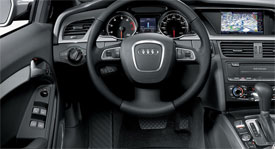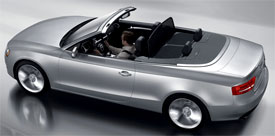2010 Audi A5 Cabriolet
Convertible season is here! And leave it to Audi to be ready with a new droptop, the A5 Cabriolet. Visually, it’s just as stunning as the coupe, but now for the real test. Let’s put on our Ray-Bans and head out on the highway. Cars don’t always make the transition from tin-top to convertible gracefully, but Audi has managed to keep their four-seat 2010 A5 Cabriolet beautifully proportioned.
Audi’s now familiar front end formula-big, rectangular LED-rimmed bi-Xenon headlights and a deep, drop jaw Nuvolari grille-is indistinguishable from the A5 hardtop. In profile, though, the power softtop makes for a longer, flatter trunklid. Whether you’re basking in the sun or keeping the rain at bay, the A5’s lines are pleasing from every angle.
Audi chose fabric over a metal droptop to save weight and bulk. It includes a glass rear window with defroster, and uses Audi’s new Acoustic Roof insulation to keep the cabin remarkably quiet. Top operation takes less than 20 seconds, even when driving up to 30 miles-per-gallon hour. Our tester’s burnt orange leather interior was trimmed tastefully in aluminum and wood. It proved comfortable for four adults, and as user-friendly as it was attractive.
 The dash caters to driver ergonomics. Gauges are clear and easy to read, and the thick-rimmed, multi-function, tilt-and-telescoping wheel is leather-wrapped. An array of airbags includes knee airbags for front-row occupants.
The dash caters to driver ergonomics. Gauges are clear and easy to read, and the thick-rimmed, multi-function, tilt-and-telescoping wheel is leather-wrapped. An array of airbags includes knee airbags for front-row occupants.
Audi’s Drive Select integrates operation of throttle, steering, and suspension, offering four distinct driver selected settings- Comfort, Auto, Dynamic, plus Individual. Feedback from Audi’s latest MMI hard-drive disc infotainment system is via the seven-inch screen mounted high in the center stack.
Our A5’s curvy, heavily-bolstered power front bucket seats featured neck-level heat vents. With the top up, there is of course sizable C-pillar blind spot. Luckily, our tester came equipped with Audi Side Assist, a useful blind-spot monitoring system in the side mirrors.
Thanks to the less bulky softtop, second-row occupants get a surprising amount of legroom, plus a wind diffuser, and rollover protection. Unusual for its class is a split folding rear seat that gives this Cabrio functional versatility. Filling all the seats still allows for a practical 10.2 cubic foot trunk, top up or top down. Most hardtop rivals have a fraction of that with the top down.
Like the Coupe, standard power is a direct-injected, turbocharged 2-liter I4. In the Cabrio it’s good for 211 horsepower and a stout 258 pound-feet of torque. For more power you’ll have to move up to the S5 Cabriolet with its supercharged 3.0-liter V6 rated at 333 horsepower and 325 pound-feet.
The 2.0, with standard front drive, transfers power through a CVT automatic. Our all-wheel drive Quattro uses a six-speed Tiptronic automatic with paddle shifters. There is no pure manual. With Quattro, this is a year-round convertible. Torque splits 40 percent front, 60 percent rear in routine driving.
 At the track, traction was in no short supply: zero to 60 took just 6.6 seconds. Turbo lag was almost non-existent, and shifts were well-spaced, if a little soft. The droptop A5’s relaxed demeanor didn’t hurt its quarter mile time: 15 seconds flat, at 90 miles-per-gallon hour.
At the track, traction was in no short supply: zero to 60 took just 6.6 seconds. Turbo lag was almost non-existent, and shifts were well-spaced, if a little soft. The droptop A5’s relaxed demeanor didn’t hurt its quarter mile time: 15 seconds flat, at 90 miles-per-gallon hour.
Through the low-speed slalom, the car’s heavily front-biased weight was apparent, but it still proved to be a nimble handler. Turn-ins were quick, and the car felt unusually solid for a convertible. We detected little cowl twist and shake. Body roll was present, but manageable.
Switchable ESP stability control, as well as ABS, are standard-issue. Four-wheel disc brakes stopped the A5 from 60 in a short average of 122 feet. Mild fade increased the distances slightly over six runs, and the pedal was soft, but stops remained smooth and straight.
Government Fuel Economy Ratings for our Quattro A5 Cabrio are 20 city, 26 highway. The front-drive droptop is rated at 23 city, 30 highway. On our test loop, the Quattro delivered an unsurprising 23.2 mpg on premium gas. Plus, with an Energy Impact Score of 14.9 yearly barrels of oil, and a Carbon Footprint of 8 tons of CO2, our A5 Cabriolet is relatively eco-friendly.
More so than prices, which start at $42,825 for the front-drive A5 Cabrio, and $44,925 for the all-wheel drive variant. But, go easy on options, the 60 grand mark is not hard to breach. Indeed, at that level it makes sense to upgrade to the S5 Cabriolet.
Still, even with the base 2010 Audi A5 Cabriolet, you’re getting a droptop that is easy on the eyes, with a sumptuous interior, and nearly impeccable road manners. Oh, and it will turn a few heads too. And, that test, like all the rest, this ragtop passes with ease.
Specifications
- Engine: Direct-injected, Turbocharged 2-Liter I4
- Horsepower: 211
- Torque: 258 Lb Feet
- 0-60 MPH: 6.6 Seconds
- 1/4 Mile: 15.0 Seconds @ 90 MPH
- 60-0 MPH: 122 Feet
- EPA: 20 MPG City/ 26 MPG Highway
- Mixed Loop: 23.2 MPG
- Energy Impact: 14.9 Barrels Oil/Yr
- CO2 Emissions: 8.0 Tons/Yr
2024 Toyota Land Cruiser
Toyota’s Go Anywhere Globetrotter Returns To U.S.
Every once in a while, we all need a reset. A time to get back to basics and prioritize the things that really matter. Well, for the Toyota Land Cruiser that time is now. So, let’s find out if that means bigger and better things for Toyota’s iconic off-roader.
The Toyota Land Cruiser’s status among the global off-road community is legendary, and it’s hard to imagine there’s any corner of the earth where a Land Cruiser hasn’t kicked up a little dust or mud. Well, 2024 sees the return of the Land Cruiser to the U.S. market after a 3-year hiatus, getting a major reset for the journey.
The reset comes mostly by no longer being based on the large three-row “300-series” chassis, but a new version of the smaller “200-series,” now known as the J250. As with the latest Tacoma, it uses the Tundra pickup’s full-size steel frame.
While the main Land Cruiser model, which goes by simply Land Cruiser, is packed full of luxury and convenience features, there is also a stripped-down model known as the 1958, honoring the first year the Land Cruiser made landfall here in North America. And it is that 1958 we have here, and we were glad to see it, as it also celebrates the original’s back-to-basics approach as a blank canvas for you to personalize as you tackle more and more adventures.
Not that it’s fully stripped down, as 8-inch touchscreen infotainment, a 7-inch full-color multi-information display, and automatic climate control are still standard. Plus, some seriously durable materials, and great heated cloth front seats that throw off some get serious 1990s Tacoma vibes.
But outside, there’s a definite lack of flashy trim and basic looking 18-inch wheels with Yokohama Geolander all-season tires; plus, big chunky bumpers and tilt-up back glass, which is a rarity that we appreciate. Though there is a little too much plastic in places that are sure to see some abuse if you do any significant off-roading.
It even feels a little rough around the edges, but for us it just adds to the rugged old-school utility vibe in a good way.
We did just that, both here in the Mid-Atlantic as well as in the California desert; and while there are some tech-forward driving aids, the actual hardware is in most cases plenty to get things done. That includes standard full-time dual-range four-wheel-drive, locking center and rear diffs, and 8.7-inches of ground clearance. A front stabilizer bar disconnect is also available to allow for increased articulation.
Who needs a V6 or even a V8 when you’ve got Toyota’s i-FORCE MAX setup at your disposal with 326 horsepower and 465 lb-ft of torque coming from a 2.4-liter turbo-four with an electric motor sandwiched between the engine and its eight-speed automatic transmission. Low speed torque delivery is impressive. It even feels a little rough around the edges, which may be a turn off to some, but for us it just adds to the rugged old-school utility vibe in a good way.
And it certainly feels quicker than an off roader needs to be, with an instant torque dump as soon as we eased on the throttle at our Mason Dixon test track; helping us get to 60 in 8.1 seconds and through the quarter-mile in 16.3 seconds at 86 mph. Considering the Land Cruiser’s terrain conquering mission, it behaved quite well in our handling course; it was plenty responsive to inputs, with less body roll than we expected and plenty of grip from the tires. The steering was light and quick but as expected didn’t provide much feel. Other than significant nosedive, braking performance was exceptional. Only 107-feet to panic stop us from 60 mph.
With the shift to the smaller size, there’s no more third row available, and cargo capacity now comes in at 46.2 cubic-feet with a max of a still healthy 82.1. Now, the best part of the Land Cruiser’s return is the entry price of $57,445. That’s about 30-grand less than what the last Land Cruiser went for back in 2021.
Whether it’s over the top fashion trends, mullets, or zombies; just when you think they’re dead, they come roaring back to life. Of course, we’re much happier to see the resurrection of this 2024 Toyota Land Cruiser than any of those things. Toyota is one brand that still recognizes the value of full-framed rugged rigs and has also acknowledged that sometimes less really is more. The Godfather of Toyota off-roading is back and better than ever.







